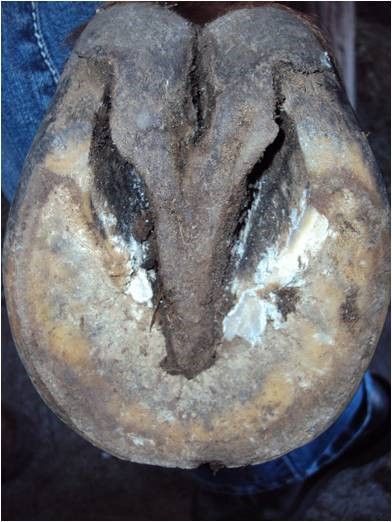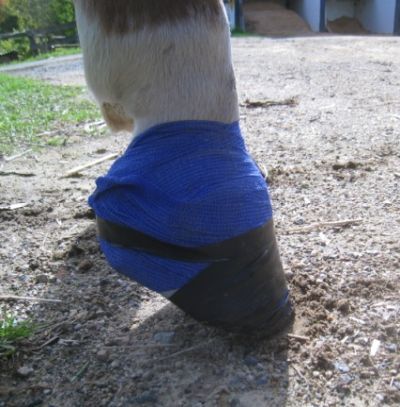SOMETIMES HOOF TRIMMING HAS TO WAIT
- By Richard van Dijk
- •
- 17 Aug, 2016
- •
Get the job done despite the dangers and bad habits, or make life easier for everyone in the long term?
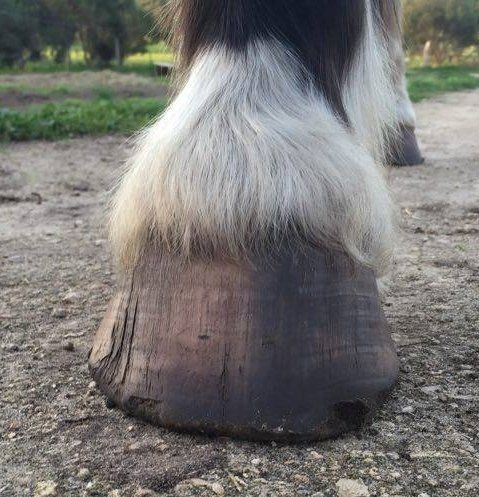
Recently, a horse arrived here for starting to saddle. She arrived with long feet in need of a
trim. I was itching to get them done
but it wasn’t that simple!
One of the first issues I found when I began to handle her was problems with leg handling. When trying to lift up a front foot, she would be inclined to paw the air and just touching or brushing a hind leg was a cue for her to walk away. She had obviously had her feet trimmed many times before she came to me but I was easily able to guess how she had been handled for previous hoof trims. I asked the owner “did the previous hoof care professional use force rather than training to get the job done? Force such as keeping the leg held up with brute strength and encouraging her to hop away, then moving with the horse until it was up against the rail or building?” The client said “Yes! That’s exactly what happened!
The previous hoof care
professional had kind of got the job done but the owner was unable to pick up
the feet for cleaning, etc. because the horse either planted it’s feet or just
moved away. This kind of forced
trimming, among other kinds such as tying the legs up, helps the hoof care
professional get the job done at the time but it doesn’t teach the horse to
stand still and hold the leg up for anyone else who may not be as strong. It also does not teach the horse to balance
and lift its own leg for you. The horse is inclined to still lean on people and
give a lot of resistance to lifting. Who
wants to work against the horse like that? Certainly not me!
We want to teach the horse to work with us,
making life easier for us and less stressful for the horse. As a hoof care professional, I can do also do
a much better trimming job when the horse is standing still and balanced rather
than when I’m fighting it. Fighting
horses damages my body and many hoof care professionals have to prematurely
retire due to bad backs/knees/hips/shoulders from fighting horses who won’t cooperate.
I believe the key is in the training but this means a bit of patience. The trimming can wait!
There are other benefits to owners of being able to handle the horses’ legs and pick up their feet easily and safely. For example, if you are riding down the road and the hoof picks up a stone, the horse needs to be able to stand still and lift its leg to get the stone out easily.
With this particular young horse, I knew I needed to train
her to cooperate with me before I even attempted to trim her feet and put
myself at risk.
I was able to train
her without tying her legs up with hobbles or any other such restraining devices. I feel that these methods also just teach a horse to stand on three
legs and not keep still and lift a leg in a balanced way on command. It’s also not convenient for us to use
straps whenever we want to achieve stillness.
How I started was to simply reinforcing standing - just standing still
while I groomed her. I brushed down her
legs and if she moved I would reach up to the lead rope and put her back in the
original place also using a verbal command “stand”.
I did this on a daily basis until the horse
felt relaxed and calm and allowed me to brush her legs without moving. Soon she let me brush her legs without
moving away and it was only after this was achieved that I attempted to lift
the legs. I also do the legs in the same
order every day because horses are creatures of habit and routine which makes
them feel confident and relaxed.
Once I got to the leg lifting stage, I engaged an assistant to help balance the horse and lighten weight on the leg I wanted to lift making it clearer and easier for her to understand what I required. I would lift for just a moment and then put it down gently. Always during these sessions, I kept to the same order and routine.
I would then do
ground work with the horse (more about this in later blogs) and groom her at
the finish, again picking up her feet.
Now, I can ask her to stand and lift her legs wherever I am, always
making sure that first she is balanced in such a way that lifting the correct
leg is easy for her, rather than me doing the work of lifting it. Once the horse was able to do this, she was
ready to trim and I could do a better job too.
Persistence and routine is the key to this leg training. This filly has now gone home with lovely feet and her owner is able to handle them easily.
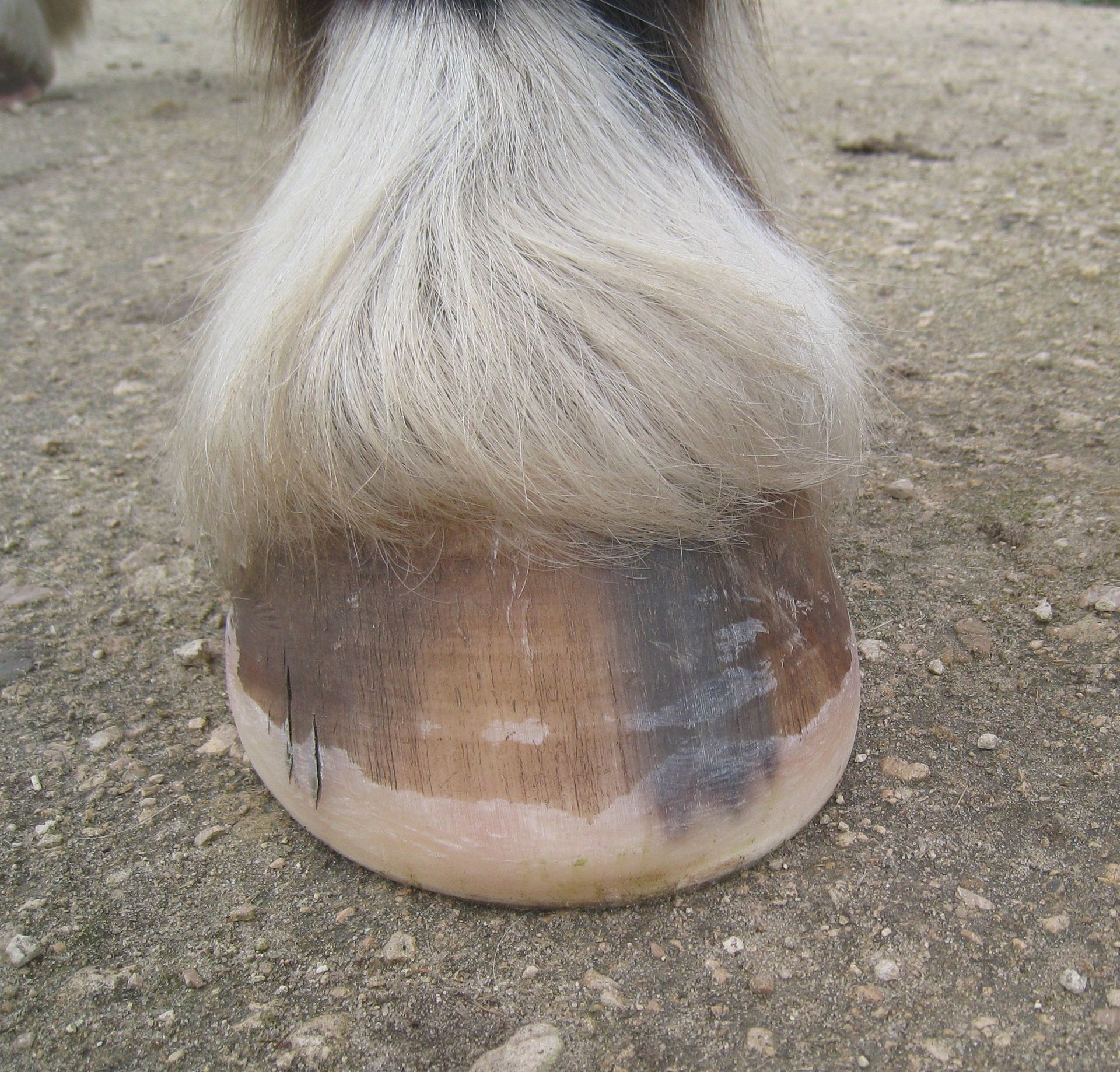
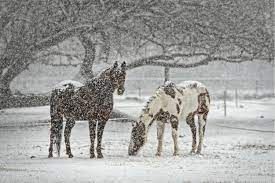

Are you aware of the Five Freedoms in the Animal Welfare Act? This Blog explains how we interpret these and put them into practice in our daily dealings with our own and clients’ horses. They are:
- Freedom from hunger and thirst: by providing enough fresh water and the right type and amount of food to keep them fit.
- Freedom from discomfort: by making sure that animals have the right type of environment, including shelter and somewhere comfortable to rest.
- Freedom from pain, injury and disease: by preventing them from getting ill or injured and by making sure animals are diagnosed and treated rapidly if they do. Animals should have access to veterinary care when needed.
- Freedom from fear and distress: by making sure their conditions and treatment avoid mental suffering.
- Freedom to behave normally: by making sure animals have enough space, proper facilities and the company of other animals of their own kind.
Number 1 Freedom of the Animal Welfare Act is “Freedom from Hunger and Thirst : by providing enough fresh water and the right type and amount of food to keep them fit”. Now this can sound very straightforward but it’s easy to get it wrong and is a massive topic. Here at TTT :
· We ensure that horses in our care have 24/7 low ESC+starch grass hay, plus grazing. If they are losing weight we might add in some higher calorie hay such as lucerne or a cereal hay.
· The most important part is that it’s 24/7 low starch, high fibre “trickle feeding” as suits horses digestive systems.
· We have in our training contract that if owners wish their horse to have a bucket feed, that they must supply that as an extra, and we are happy to give them whatever is instructed.
· We will contact the owner and suggest a more energy dense bucket feed if the horse is losing weight on hay/grass.
· Our own horses have a small feed of rinsed and soaked beet pulp, lucerne chaff, salt, a custom mineral mix and some have other supplements as needed for joint and gut health.
· Our horses, if in work, will have soaked, cracked lupins added and we give whole oats after hard work.
· Of course, we always have fresh water available.
· We have heard recently of a trainer using feed/water restriction as a training tool – that is cruel and unnecessary and would never, ever happen here.
Number 2 Freedom of the Animal Welfare Act is “Freedom from Discomfort by making sure that animals have the right type of environment, including shelter and somewhere comfortable to rest.”
This one is fairly simple- here at TTT:
· Horses are paddocked with a suitable companion, not yarded or stabled, with room to browse and move around. There’s soft sand to sleep on, trees for shelter and a lovely outlook.
Number 3 Freedom of the Animal Welfare Act is “Freedom from pain, injury and disease: by preventing them from getting ill or injured and by making sure animals are diagnosed and treated rapidly if they do. Animals should have access to veterinary care when needed.”
This one is not as straightforward as it seems and is closely linked to Number 1 and 4. Here at TTT:
· Equipment is tailored for the comfort of each horse, not for the trainers’ comfort, to eliminate pain from ill-fitting equipment.
· We never hit or beat a horse with anything.
· We never tie up their legs or similar acts which cause pain and injury.
· We don’t work horses to exhaustion or expect paces that they are not physically ready for.
· The environment is free from hazards and as safe as we can make it to minimise risk of injuries.
· We ask owners to have their horses in good condition upon arrival, with their teeth and worming recently attended to and with full disclosure of previous injuries, illness and disease.
· We only provide companions which are suitable for settling new horses, not those which will harass or are aggressive.
· We feed as per Freedom Number 1 to keep the horses healthy
· Owners are notified immediately of any health concerns and our contract states that we will call a Veterinarian anyway if we deem it necessary but we can’t reach the owner first.
Number 4 Freedom of the Animal Welfare Act is “Freedom from fear and distress: by making sure their conditions and treatment avoid mental suffering”.
This one is also complicated and very much open to interpretation. Here at TTT:
· Our training method keeps the horses stress levels under their fear threshold. The physical signs of stress have been identified and well documented by the equestrian science community and because of our extensive experience we are able to immediately identify the symptoms of stress. Anything that escalates stress and adrenaline is counter-productive to good learning.
· We don’t implement some common and popular training methods that can cause fear and distress. For example, excessive use of the round pen; excessive circling/lunging; use of restraints e.g. hobbles, side reins and the like; excessive use of lateral movements, etc.
· We aim for calm at all times and achieve this by breaking down training outcomes into individual elements, then establishing one outcome at a time until it is thoroughly understood. Richard’s Passive Focus Exercise is one way to attain calm.
· We do not progress to faster gaits until we have established good responses to our aids in the slower paces and until the horse has developed good strength and balance. This ensures smooth transitions, communication and minimum stress at all paces.
Some points are copied from Freedom Number 3 as they overlap, i.e. physical and mental suffering can be caused by the same thing -
· Equipment is tailored for the comfort of each horse, not for the trainers’ comfort, to eliminate pain (and distress) from ill-fitting equipment.
· We never hit or beat a horse with anything (causes pain and distress)
· We never tie up their legs or similar acts which cause pain and injury (and distress)
· We don’t work horses to exhaustion or expect paces that they are not physically ready for.
· We only provide companions which are suitable for settling new horses, not those which will harass or are aggressive.
Number 5 Freedom of the Animal Welfare Act is “Freedom to behave normally: by making sure animals have enough space, proper facilities and the company of other animals of their own kind.”
This one overlaps and encompasses the first 4 Freedoms. So, as a summary, here at TTT:
· Horses have 24/7 spacious paddock living with grazing or ad-lib mixed species grass hay
· They have carefully matched companions
· They have trees and valleys for shelter
· They are very closely observed throughout the day (and we can hear them at night)
· We are extremely experienced and notice the tiniest issues before they escalate
· We are educated in nutrition, hoof care, conformation and riding disciplines
· Emotional, mental and physical health of the horses is our number 1 priority
Richard van Dijk & Jenny Austin

